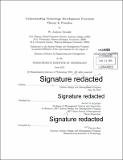| dc.contributor.advisor | Steven D. Eppinger. | en_US |
| dc.contributor.author | Oswald, W. Andrew (William Andrew) | en_US |
| dc.contributor.other | System Design and Management Program. | en_US |
| dc.date.accessioned | 2014-10-08T15:23:34Z | |
| dc.date.available | 2014-10-08T15:23:34Z | |
| dc.date.copyright | 2013 | en_US |
| dc.date.issued | 2013 | en_US |
| dc.identifier.uri | http://hdl.handle.net/1721.1/90699 | |
| dc.description | Thesis: S.M. in Engineering and Management, Massachusetts Institute of Technology, Engineering Systems Division, System Design and Management Program, 2013. | en_US |
| dc.description | Cataloged from PDF version of thesis. | en_US |
| dc.description | Includes bibliographical references (pages 75-77). | en_US |
| dc.description.abstract | Technology development is hard for management to understand and hard for practitioners to explain, however it is an essential component of innovation. While there are standard and predictable processes for product development, many of these techniques don't apply well to technology development. Are there common processes for technology development that can make it predictable, or is it unpredictable like basic research and invention? In this thesis, after building a foundation by looking at product development processes, I survey some of the literature on technology development processes and compare them to a handful of case studies from a variety of industries. I then summarize the observations from the cases and build a generic model for technology development that can be used to provide insights into how to monitor and manage technology projects. One of the observations from the product development literature is that looping and iteration is problematic for establishing accurate schedules which becomes one of the fundamental disconnects between management and engineering. Technologists rely heavily on iteration as a tool for gaining knowledge and combined with other risks, technology development may appear "out of control". To mitigate these risks, technologists have developed a variety of approaches including: building a series of prototypes of increasing fidelity and using them as a form of communication, simultaneously developing multiple technologies as a hedge against failure or predicting and developing technologies they think will be needed outside of formal channels. Finally, I use my model to provide some insights as to how management can understand technology development projects. This gives technologists and non-technical managers a common ground for communication. | en_US |
| dc.description.statementofresponsibility | by W. Andrew Oswald. | en_US |
| dc.format.extent | 92 pages | en_US |
| dc.language.iso | eng | en_US |
| dc.publisher | Massachusetts Institute of Technology | en_US |
| dc.rights | M.I.T. theses are protected by copyright. They may be viewed from this source for any purpose, but reproduction or distribution in any format is prohibited without written permission. See provided URL for inquiries about permission. | en_US |
| dc.rights.uri | http://dspace.mit.edu/handle/1721.1/7582 | en_US |
| dc.subject | Engineering Systems Division. | en_US |
| dc.subject | System Design and Management Program. | en_US |
| dc.title | Understanding technology development processes theory & practice | en_US |
| dc.title.alternative | Understanding technology development processes theory and practice | en_US |
| dc.type | Thesis | en_US |
| dc.description.degree | S.M. in Engineering and Management | en_US |
| dc.contributor.department | System Design and Management Program. | en_US |
| dc.contributor.department | Massachusetts Institute of Technology. Engineering Systems Division | |
| dc.identifier.oclc | 890946378 | en_US |
